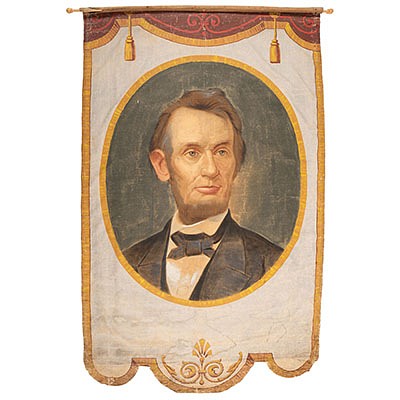[CIVIL WAR]. A group of 3 CDVs of Federal warships, incl. USS General Price, Magnolia, and Black Hawk.
About Seller
6270 Este Ave.
Cincinnati , OH 45232
United States
With offices in Cincinnati, Cleveland and Denver, Cowan’s holds over 40 auctions each year, with annual sales exceeding $16M. We reach buyers around the globe, and take pride in our reputation for integrity, customer service and great results. A full-service house, Cowan’s Auctions specializes in Am...Read more
Two ways to bid:
- Leave a max absentee bid and the platform will bid on your behalf up to your maximum bid during the live auction.
- Bid live during the auction and your bids will be submitted real-time to the auctioneer.
Bid Increments
| Price | Bid Increment |
|---|---|
| $0 | $25 |
| $500 | $50 |
| $1,000 | $100 |
| $2,000 | $250 |
| $5,000 | $500 |
| $10,000 | $1,000 |
| $20,000 | $2,500 |
| $50,000 | $5,000 |
| $100,000 | $10,000 |
About Auction
Jun 25, 2021
The June 25 American Historical Ephemera and Photography Auction features an exciting assemblage of 18th-early 20th century material, including Civil War archives, Early Photography, Western Americana, Autographs and Manuscripts, and more. Cowan's Auctions dawnie@cowans.com
- Lot Description
CDV of tinclad General Price. Baton Rouge: A.D. Lytle, [1860s]. (Soiled front and back with soft corners, ink inscription on verso undamaged and easy to read, strong clarity and tones.) Detailed period inked inscription on verso, which reads, "A very good picture of the / USS General Price taken as / she laid off Baton Rouge. / The plantation & sugar house/opposite. The orange trees/green. Steps on the starboard / quarter. A boat hoisted on/the starboard davits / with a canvas over over it. / Horns on the pilot house. Shield / between the chimneys. That / that looks like doors on the / stern bulkhead are pikes. / 2 racks of 12 each. The / wardroom is underneath the pilot house." Familiarity with the details of the ship and the mention of the wardroom suggest that the unknown writer was one of the Price's officers.
General Price was originally a civilian sidewheel steamboat taken into Confederate service in 1861 as the CSS General Sterling Price. In May 1862 off Fort Pillow she and her sisters attacked vessels of the Mississippi Squadron in an action known as Plum Point Bend. During the fight the General Bragg and then the General Price concentrated on the Union gunboat Cincinnati which was rammed and heavily damaged by Price. She also managed to silence a nearby federal mortar boat but received extensive damage in exchange being "struck by a 128-pound shell which cut off her steam supply and caused a dangerous leak." She fought at the Battle of Memphis on 6 June 1862 against a decidedly superior Union force without a semblance of tactical expertise. In the ensuing chaos Price collided with the CSS Beauregard while attempting to ram the USS Monarch. She then struck Ellet's Queen of the West whose crew boarded her as she slowly settled on a sandbar. She was raised by the Union and taken into Federal service at Cairo as the USS General Price on 30 September 1862. General Price was heavily involved in the Vicksburg campaign in March and April 1863, taking part in the Mississippi Squadron's run past the Confederate fortress city on 17 April. She then operated against Grand Gulf ferrying Grant's infantry across the river and escorting troop transports. Price also sortied against Fort De Russy aiding in its destruction, and later on a reconnaissance up the Black River where she bombarded Confederate batteries at Harrisonburg, Louisiana. During the siege of Vicksburg she joined the general cannonade and directed her artillery in support of Grant's land operations that finally resulted in the surrender of the bastion on 4 July. Afterwards, Price "took up regular cruising station on the lower Mississippi, protecting transports, landing reconnaissance parties, and keeping the river free from Confederate guerrillas." On 8 March 1864, General Price accidentally rammed and sank the USS Conestoga. She took part in the ill-fated Red River Expedition during April-May. General Price was decommissioned in July 1865 and sold out of service in October.
CDV of the USS Magnolia taken in profile from the shore. N.p.: n.p., [1860s]. (Toning, corner/edge wear to mount.) Magnolia was a seagoing sidewheel steamer impressed by the Confederacy at New Orleans in January 1862 and employed briefly as a blockade runner. She made two successful runs to British Caribbean possessions before being captured near the entrance to Mobile Bay on 20 February 1862 by the USS South Carolina hot in pursuit. She was subsequently taken over by the US Navy and assigned to blockade duty out of Key West in July 1862. During her war cruises Magnolia took three blockade runners with valuable cargo. Towards the end of the war she was assigned to blockade St. Marks, Florida where volunteers from her crew joined an army land expedition that fought at the battle of Natural Bridge on 5-6 March 1865. Four of Magnolia's company were awarded the Medal of Honor. She was decommissioned in June 1865 and sold out of service the next month.
CDV of the USS Black Hawk, flagship of the Mississippi Squadron. Mound City, IL: J.B. Leonard, [1860s]. (Toning, corner/edge wear to mount.) USS Black Hawk, a large side-wheel steamer built in New Albany, Indiana (1848) was taken up from the civilian trade by Navy purchase at Cairo, Illinois, and commissioned 6 December 1862. Black Hawk spent her entire Brown Water Navy career as flagship for Rear Admiral David Porter, Captain Alexander Pennock, and Rear Admiral Samuel P. Lee, successive commanders of the Mississippi Squadron. Beginning in December 1862 she participated in the early stage of operations to clear the Mississippi in preparation for the investment of Vicksburg. First contact resulted in the capture of the strategically located Fort Hindman at the Battle of Arkansas Post on 11 January 1863, but achieved little else other than the taking of 4,900 ragtag Rebel prisoners. Later in the year Black Hawk was part of W.T. Sherman's deception attack utilizing combined army-navy forces against Haines Bluff, Mississippi to draw off and pin Confederate forces intended for Vicksburg. As the noose tightened on Vicksburg, Black Hawk joined in the routine bombardment of the city during final siege operations. Afterwards, the task of the Mississippi Squadron largely realigned to one of army cooperation, transport and supply, interspersed with up tempo operations during the Red River Campaign. Black Hawk accidentally burned and sank near Cairo on 22 April 1865.
The Richard B. Cohen Civil War Collection Lots 79-98; 116; 138-153; and 266
Cowan's is pleased to offer the third installment of Richard B. Cohen's collection of Civil War Brown Water Navy photography. Richard was known to many in the field as a "disciplined collector who maintained a relatively narrow focus having built an important, perhaps unsurpassed collection in his area of specialization." From cartes de visite to large format photographs, this portion of the collection features a noteworthy selection of images of Brown Water Navy warships, among them, the USS Benton, Choctaw, Lafayette, and Louisville. Many important identified naval officers are also represented, including an exquisite CDV of the promising young officer, Lieutenant Commander William Gwin, who died of wounds aboard the USS Benton following an artillery duel with Confederate forces at Snyder's Bluff, and an exceptionally large war-date photograph of the controversial commander of the USS Pittsburgh, Egbert Thompson.
This auction also features a premiere selection of autographs and manuscripts from Richard's carefully curated collection. Highlights include a letter from Jefferson Davis to his distant cousin, John J. Pettus, Governor of Mississippi, dated a year before secession, conveying intricate plans for securing armaments in preparation for the war; an Abraham Lincoln signed endorsement; a letter from Admiral D.G. Farragut from New Orleans, offering excellent insight into his "political" thinking as well as his dedication to his work; correspondence from Gideon Welles, David Dixon Porter, U.S. Grant, and W.T. Sherman; and a pair of superb letters with highly descriptive accounts of the Battle of the Monitor and Merrimac.
Provenance: The Richard B. Cohen Civil War Collection - Shipping Info
-
SHIPPING & PICKUPS Cowan’s Cincinnati Office offers an in-house, full-service shipping department which is unparalleled in the auction industry. Shipping costs are provided with your finalized invoice 24-48 hours after auction. For furniture and oversized items, we recommend using third-party services. For more information, contact cowansshipping@hindmanauctions.com. NOTE: All pickups and preview are by appointment only. To make an appointment, please call 513-871-1670 or email cincinnati@hindmanauctions.com Buyers are required to pay for all packing, shipping and insurance charges. Overseas duty charges are the responsibility of the successful Bidder. Be aware that for larger and/or valuable items, shipping charges can be substantial. - Shipping charges include insurance for your order while in transit. If you have private insurance we will adjust your charge to include only packing and shipping. - Please allow 14 – 21 days after payment to package and ship your purchase as carefully as possible.
-
- Buyer's Premium



 EUR
EUR CAD
CAD AUD
AUD GBP
GBP MXN
MXN HKD
HKD CNY
CNY MYR
MYR SEK
SEK SGD
SGD CHF
CHF THB
THB![[CIVIL WAR]. A group of 3 CDVs of Federal warships, incl. USS General Price, Magnolia, and Black Hawk.](https://s1.img.bidsquare.com/item/l/8589/8589671.jpeg?t=1LMY7j)
![[CIVIL WAR]. A group of 3 CDVs of Federal warships, incl. USS General Price, Magnolia, and Black Hawk.](https://s1.img.bidsquare.com/item/s/8589/8589671.jpeg?t=1LMY7j)











